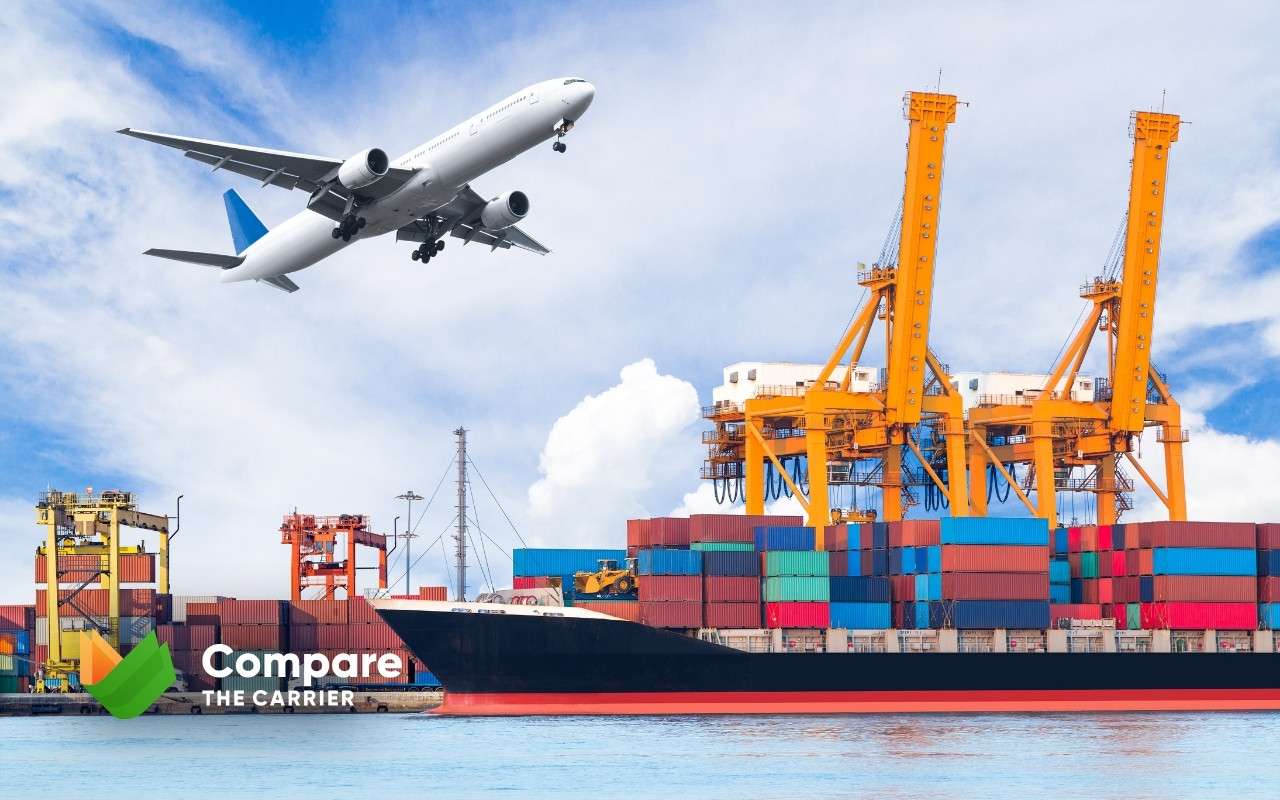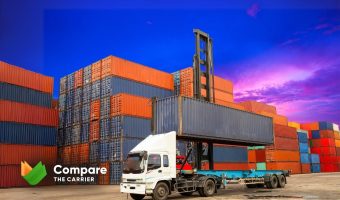Ever wondered how the latest gadgets land on your doorstep or how coffee from distant lands fills your cup every morning?
That’s freight shipping for you, the unsung hero of our everyday convenience. It’s the muscle behind every product’s journey from the assembly line to your front door.
And here at Compare The Carrier, we’re all about pulling back the curtain to reveal a world of shipping that’s efficient and user-friendly. If you’ve got goods to move, we’re your trusty sidekick, connecting you with the best licensed carriers in the business. Saving you time, money, and a whole lot of headaches, we’re here to make sure that freight shipping feels like a breeze.
Understanding Freight Shipping: Basics and Beyond

What is freight shipping, you ask? It’s the heavy lifter of the economy, the process that moves goods in bulk across land, sea, or sky. When your shipment is too large for standard mail, it enters the realm of freight shipping services – a complex system that ensures your goods arrive safely and on time.
Freight vs. Parcel: Knowing the Difference
Freight shipping differs from sending a small parcel. It deals with larger, heavier shipments requiring special handling and logistics planning. It’s like the difference between a family car and an 18-wheeler — both get you places, but the scale and requirements differ vastly.
Freight Delivery Methods
With freight delivery, your options vary:
Each method suits different needs, balancing speed, cost, and cargo type (USDOT).
Navigating Freight Services
Freight services encompass more than just moving items; they include ancillary services that facilitate the entire shipping process. This can involve warehousing, inventory management, and more, making it a comprehensive approach to logistics (BTS).
In the US, the freight industry is not just a business necessity but also a critical infrastructure component that keeps the country running, impacting everything from local businesses to international trade (ATA).
In essence, freight shipping is the unsung hero of the global market, connecting businesses, markets, and consumers with efficiency and reliability. And with a resource like Compare The Carrier, this complex industry becomes accessible and manageable for businesses of all sizes.
Types of Goods Commonly Shipped and Their Requirements
When you dive into the world of freight shipping, you’ll find a diverse cargo landscape. From the food on your table to the car in your driveway, almost everything has been on a freight journey. Understanding the types of goods that trek across our country and beyond, and their specific shipping needs, is crucial whether you’re a business owner, a logistics coordinator, or just plain curious.
A Spectrum of Shipments
The variety of goods transported through freight shipping services (Federal Motor Carrier Safety Administration (FMCSA)) is vast, but here’s a snapshot of what typically hits the road, rails, sea, or sky:

Knowing the Needs
Different goods come with their own playbook for freight delivery. Let’s look at what some of these items need during their journey:
For Consumer Goods:
For Perishables:
For Industrial Equipment:
For Vehicles:
For Hazardous Materials:
Freightment completely encompasses a broad array of items, each with its unique set of requirements to ensure safe and efficient transport. Whether it’s fresh food that needs to stay cold or a new car that needs to arrive without a scratch, the world of cargo transportation is equipped to handle it all, connecting products with people, no matter the distance or complexity.
Key Players in the Freight Shipping Chain
The freight shipping process is a team effort, with each member contributing to a smooth operation from origin to destination. Here’s a condensed look at who’s who in the world of cargo transportation.

Shippers
Shippers kickstart the process. They’re manufacturers, producers, or distributors looking to transport goods. Their role is critical in preparing and packaging freight for its journey.
Carriers
Carriers are the backbone, providing the physical means to move freight. This group spans across truck drivers, rail companies, shipping lines for sea transport, and air freight carriers for the quickest delivery options.
Intermediaries
Freight Brokers and Freight Forwarders serve as liaisons, linking shippers with carriers and handling the intricacies of transportation, such as negotiating contracts and ensuring shipments comply with all regulations.
Regulatory Bodies
Organizations like the Federal Motor Carrier Safety Administration (FMCSA) set the rules of the road, ensuring safe and lawful transportation, especially when it involves hazardous materials.
Logistics Service Providers
Logistics Service Providers (LSPs) include warehouse operators who manage goods before and after transit, and technology providers who develop tools for tracking and managing shipments.
Customers
Ultimately, it’s all for the Customers, who expect their items delivered on time and in perfect condition, driving the standards for the entire freight chain.
This streamlined network of key players ensures that freight shipping remains a reliable pillar of global trade and supply chains.
Selecting the Right Mode: Factors to Consider
Selecting the right mode for your freight can be straightforward when you weigh these essential factors:

\Now that you’ve got a handle on the essentials of selecting the right freight shipping mode for your cargo, you might be wondering how it stacks up against auto transport shipping.
Each has its nuances and use cases, especially when it comes to specialized cargo like vehicles. To give you a clearer picture of how these two shipping methods compare and to help you make the best decision for your transportation needs, take a look at our video “Freight Shipping vs. Auto Transport Shipping.”
Dive in for an in-depth exploration of the differences and when to choose one over the other.
Freight Shipping Documentation: A Checklist
Navigating the paperwork for freight shipping services can feel like steering through a stormy sea. To ensure your freight delivery or cargo transportation sails smoothly from port to port, a tight ship when it comes to documentation is essential. Here’s a streamlined checklist to keep your freightment completely in check:

Remember, each shipment can have its nuances, so always check for any additional documents you might need. Keeping this checklist at hand will help you ensure that nothing gets overlooked in the hustle and bustle of getting your freight on the move.
Overcoming Common Freight Shipping Hurdles
In the bustling world of freight shipping services, obstacles are as common as traffic on the freeway. But with a little know-how, you can navigate through these challenges and ensure your freight delivery reaches its destination without a hitch. Here’s how you can overcome some of the most common freight shipping hurdles:

By anticipating these common issues and planning accordingly, you can ensure your freightment is not only delivered completely but also delivered on time and in perfect condition. Keep these tips in your back pocket, and you’ll be well on your way to smooth sailing through the complex world of cargo transportation.
Freight shipping is the lifeline that keeps the global economy pulsating, delivering everything from raw materials to finished products across towns and time zones.
By understanding the basics, knowing the types of goods shipped, identifying key players in the chain, selecting the right shipping mode, preparing proper documentation, and learning how to navigate through common hurdles, businesses and individuals can ship with confidence.
With Compare The Carrier by your side, offering a comparison of licensed and professional carriers, your journey through the complexities of freight shipping will be streamlined, saving you time and money.
Whether it’s for personal ventures or business endeavors, mastering the art of freight shipping services is an invaluable skill in today’s interconnected world.
FAQ
How is the cost of freight shipping calculated?
The cost of freight shipping is typically based on the weight and dimensions of the shipment, the distance it needs to travel, the mode of transportation, and any additional services such as expedited shipping or special handling.
Do I need to purchase additional insurance for my freight shipment?
While carriers offer a basic level of insurance, it may not cover the full value of your goods. It’s often recommended to purchase additional insurance for valuable shipments or for items that are prone to damage.
How should I pack my items for freight shipping?
Items should be packed securely on pallets or in crates, with adequate padding and stabilization to prevent movement and damage during transit. Fragile items should be clearly marked, and all packaging should comply with carrier and industry standards.
What are LTL and FTL in freight shipping?
LTL stands for Less Than Truckload, which means your shipment will share space on a truck with other shipments. FTL stands for Full Truckload, which is used when you have enough goods to fill an entire truck or when you prefer a dedicated truck for your shipment. Learn the key differences between these two options and how they impact the cost, time, and overall shipping experience in our article.
Can I ship hazardous materials via freight shipping?
Yes, but shipping hazardous materials requires strict adherence to regulations, proper documentation, and labeling, as well as choosing carriers that are certified to handle hazardous materials. Always check with your carrier for specific requirements.
What happens if my freight shipment gets damaged during transit?
If your shipment is damaged, report it immediately to the carrier. Keep all packaging and goods as they were on arrival for inspection. Claims should be filed promptly as carriers have specific time frames for receiving them.












